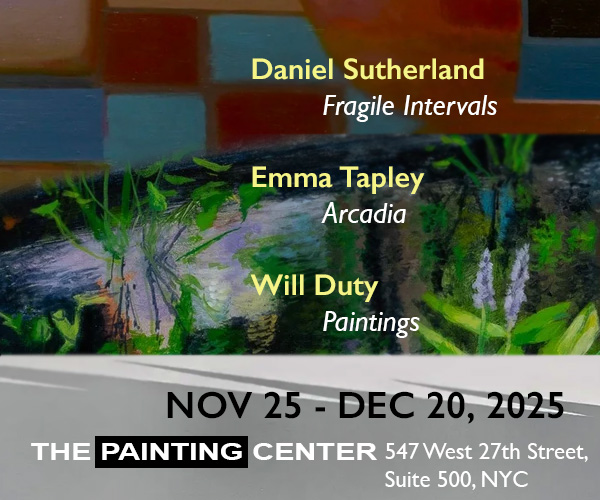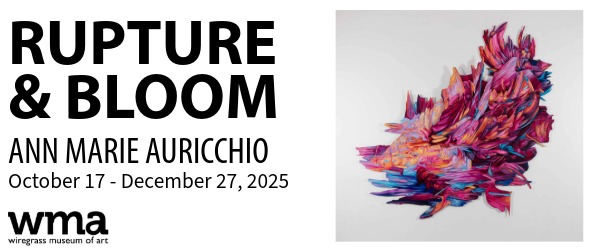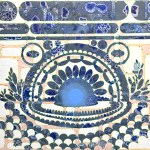
Contributed by Neil Daigle-Orians / Walking in to Hartford’s Artspace Gallery, the viewer is immediately struck by a large, hand-painted green screen. Merging the analog with the digital, Michael Siporin Levine’s set up for Vision Test lingers outside the context of his performative projection. Looking across, we see paintings by Blake Shirley and Erin Koch Smith seemingly merge together in conversation. Similar to these amorphous compositions, sculptural forms made by Shauna Merriman create boxy rectangular forms that attempt to break out of their rigid format. In the context of Hartford and central Connecticut, where the contemporary art scene is in flux, the exhibition requires the viewer to work a bit harder than they might have expected. My initial reaction to “Build a house, dig a hole“ is agreeably intriguing.
Recognizable characters (a hand, a ceiling fan, a chair, a face, etc.) shift in and out of legibility, forcing me to wonder what is actually going on in these works. Abstractions muddy the imagery in the paintings, prints, and sculptures–if there was any to begin with. Each artist flattens and condenses information from bodies, spaces, and objects.

Shirley and Smith’s paintings connect in purposeful ways. While it doesn’t take long for the viewer to discern either artist from one another, the moment’s of — which is which? — speak to shared experiences and interests rather than causing a confusion of aesthetic similarities. They are both clearly interested in Painting (with a deliberate Capital P), utilizing the languages and histories to create ghostly, ethereal canvases. Smith’s paintings especially leave little moments and hints, giving the viewer who chooses to stick around a little gift — maybe you’ll recognize a leg, complete with work boot, tube sock, and kneecap. Shirley’s paintings seem calculated to confuse the viewer, in a wonderful way. Within the context of the show, titles like Heads and Labyrinth have me second-guessing what I am looking at versus what I should be looking at.
It’s often hard to interact with work utilized during a performance outside its intended context. During Levine’s Vision Test, music and projection activated the entryway, making anyone late to the May 9th reception complicit in the performance through shadows, or evoking that awkward is it ok for me to enter this space? feeling that anyone who consumes contemporary art has experienced at least once. Levine himself intervened with the projection a few times, taking down the hats and placing them on the ground in front of the screen. Ultimately, while the projection animated select shapes and textures, he rolled back the screen to reveal a painting that became activated through the animations. The green screen, a facade of a facade, remains standing outside of the performance, asking viewers who didn’t see it to question its role in the exhibition. Where the shade and scale points to post-production digital video editing, the application of paint to the curtain creates a useless green screen. The other works in the exhibit behave similarly — a useless lamp, or window, or head without a body. As a result, the Vision Test screen and hats justify their existence on their own without the activation of a performer.
Merriman’s forms seem to take notes from Shirley and Smith’s viscous paintings, creating structural versions of them installed in the space. Pillar Robbing utilizes materials scavenged by Merriman while on a residency in Northern Appalachia, using the remains of dumps, structural collapses, and trace amounts of remaining minerals left in coal mines. Mixing these materials with Logan Sewer Pipe Company’s clay body, the pieces themselves generate a conversation about natural, human intervention, and the residue of ecological mistreatment.

Levine’s monoprints are especially curious. The brushstrokes on plexiglass mimic the wood grain texture of other plates, creating moments where painterly marks meet extremely graphic shapes. His collage-like approach to creating these prints plays with my mind, making me assume they’re cut-and-paste when in reality they’re created just using a press and very clever registration. This very print-heavy aesthetic stands out next to the more painterly works of Smith, Shirley, and even Merriman, but instead of coming off as disparate, they breathe an exciting energy into the rest of the show.
My only wish is for more breathing room in the exhibition to allow reflection on the works. As it stands, “Build a house, dig a hole” feels cluttered. But maybe that denial of silence adds something to the experience. The works don’t inherently scream at me, but their close presence next to one another creates a dull roar. Having shown in that space, I know how difficult it can be to use it. Pillars awkwardly break up the gallery, denying the viewer an option of taking in the full composition of any given wall. Perhaps with that in mind, the cluttered curation of these works makes more sense.
Much like how these compositions and objects are pushing shapes and colors together, pushing the pieces closer almost forces a dialogue to occur, whether the viewer wants it or not. The title, “Build a house, dig a hole,” creates a command to the audience. Similarly, the works themselves ask us to seek out meaning in the materials and compositions. They don’t demand it, but patiently ask or invite the viewer. Like a middle school substitute teacher trying to calm down a rowdy class with passive-aggression, they seem to say “it’s ok, we can wait.”

“Build a house, dig a hole“ Hartford Art Space Gallery, Hartford, CT. May 9 through 31, 2019. Artists include Blake Shirley, Shauna Merriman, Michael Siporin Levine, Erin Koch Smith.
About the Author: A graduate of the University of Connecticut’s MFA Program, Neil Daigle Orians is currently the visual arts coordinator at Real Art Ways in Hartford.






















